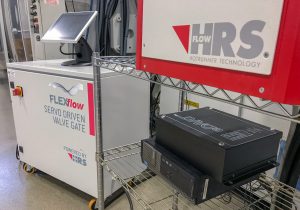
HRSFlow and RJG partner to provide advanced process control
Canadian Plastics
Plastics Processes Research & DevelopmentBy combining HRSflow’s servo-driven FLEXflow hot runner with RJG’s sensors and eDART controller, the two companies say they’re able to sequence mold filling based on what’s actually happening inside the mold cavity.
Injection molding specialist RJG Inc. has partnered with hot runner systems supplier HRSflow to provide an advanced process control solution, specifically for sequential valve gate control.
The new technology can control the sequencing of servo-driven valve gates on the basis of what’s happening inside the mold cavity, improving process consistency and part quality while opening up new design dimensions and allowing the use of smaller tonnage machines.

By combining HRSflow’s Flexflow with RJG’s eDART, molders can control hot runner systems based on conditions within the tool.
The technology was first showcased in early December at HRSFlow’s North American headquarters in Byron, Center, Mich. The two companies conducted a demonstration that included placing sensors in three different-sized cavities of a family mold. In addition, they strategically placed temperature sensors, which communicate with the advanced servo-driven valve gate FLEXflow hot runner system via the RJG eDART system.
The mold, a demo family tool for automotive interior door panel parts, was designed in order to test the capability of the whole system to withstand difficult process conditions while still ensuring optimal part production. The system was first tested through advanced mold filling simulation to establish initial process parameters. A variety of cavity sensors were instrumented to monitor cavity pressure, mold temperature, and mold deflection and their response to the FLEXflow system controlling the process parameters of both the mold filling (speed and pressure control at each gate independently) and the valve gate sequencing.
“Results showed that systematic engineering and simulation efforts, integrated intelligent molding systems, and flexible servo-driven hot runner technology greatly minimized the risks associated with a new tool launch,” said Robert Harvey, HRSflow’s North American sales director. “In addition, it facilitated process development, assured consistent part quality in various molding conditions, and allowed new design possibilities that would traditionally be excluded.”
Using this newly designed valve gate control system opens up many opportunities for cost savings through larger process windows, Harvey said, increased quality, lowered scrap, and increased yield. “The repeatability of the servo valve gate systems ensures this benefit across all shifts and operator skill levels,” he said. “Fallout due to quality of Class A surfaces can be minimized through greater control of flash, sinks, short shots, knit lines, and warp.” And with greater control of flow regulation, clamp tonnage of the machine used for a given mold can generally be reduced, he added, potentially allowing molds to run in smaller, faster, less costly machines. “Independent control at each gate eliminates the processing compromise associated with family molds, allowing for the consolidation of components in molds to reduce the total project tooling costs,” he said.
“Sequencing based on mold-based events rather than time or screw position, allows a process to be responsive to actual conditions in real time,” Harvey continued. “This collaboration with RJG makes what was once impossible possible – we can now provide a user-friendly customer experience while migrating even closer to industry 4.0 interfaces.”
